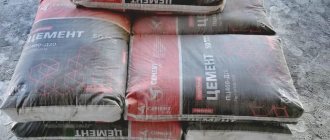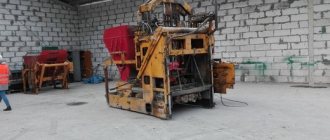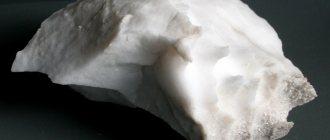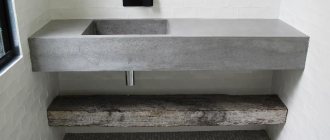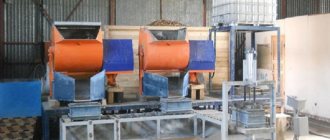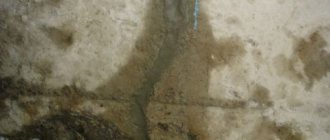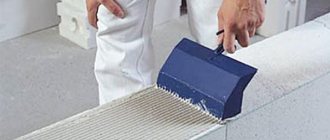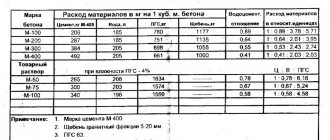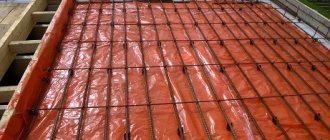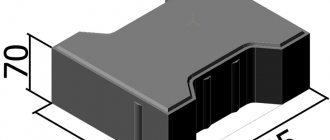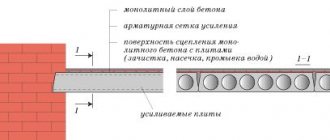Shotcrete is widely used in repairs of reinforced concrete structures, strengthening of underground tunnels and ready-made concrete structures. By adding special fillers, surfaces with additional properties are obtained, for example, frost-resistant or fire-resistant. The shotcrete method allows you to create structures with non-standard shapes, as well as reduce costs and shorten construction time.
What is shotcrete?
Another name for sprayed concrete is the layer-by-layer application of a sand-cement mixture with compressed air using a special installation. Thanks to this supply of solution, strong adhesion of concrete particles to the structure is formed. Builders note that such structures are characterized by special density, mechanical strength, frost resistance, and moisture resistance.
Shotcreting of concrete has such a feature - the ability to apply concrete to both horizontal, vertical and inclined surfaces, without the need for formwork.
About shotcrete
Shotcrete stages
To achieve high quality of the resulting coating, it is necessary to strictly adhere to the requirements of the technological regulations, follow the recommendations of the material manufacturer, and have experience in applying the composition and servicing equipment. Failure to comply with these conditions can lead to defects (lag from the base, formation of voids, deviation from the required thickness, etc.), which are quite problematic to eliminate after completion of all work.
Surface preparation
Perhaps one of the most significant criteria responsible for obtaining a high result of the work performed is the quality of the prepared base surface. A well-prepared base ensures high adhesion with the applied composition, due to which the base and the shotcrete layer in the future perceive loads as a single structure.
Surface preparation steps include:
- Removal of weakened concrete and existing coatings
- Cleaning from traces of dirt, corrosion, degreasing
- Abrasive finishing for roughening
- Joining existing cracks to increase the adhesion area with the gunite composition
- Reinforcement device (installation of mesh using anchors)
- Installation of beacons for applying a composition of a certain thickness
- Water jetting ensures removal of dust/small concrete particles/dirt residues and saturation of the base with water. This is required so that the base does not absorb moisture from the solution, thereby violating the conditions for its strengthening.
Mixture preparation and application process
Shotcrete mixture is a sand composition based on a binder (cement, Portland cement). The composition may contain coarse filler, additives to impart certain properties (frost resistance, fire resistance, etc.), fiber fiber. With the wet shotcrete method, the solution is prepared in advance. It is important to observe the proportions and follow the manufacturers' instructions when using ready-made dry concrete mixtures. In addition, it is very important to control the air temperature when preparing the composition, applying it to the surface, as well as the temperature of the base itself. The air temperature should not be lower than +5°C. The spraying of the gunite composition is carried out in layers. The application angle is 90° to the surface, with the exception of filling the space behind the reinforcement. During the work, pressure must be constantly monitored, the rate of release of the solution must be monitored, and the equipment must be cleaned in a timely manner, not allowing the composition to harden inside. The intervals between applying layers should not exceed 2-4 hours. The use of supplements can shorten this time. The freshly applied composition needs care to avoid moisture loss. To do this, moistening and coating with special film-forming compounds are carried out to prevent moisture evaporation. If necessary, the surface is refined (grinding). With the wet method, it is allowed to level the surface immediately after applying the gunite composition. Shotcrete is work on the repair of concrete and brick surfaces, allowing you to restore the structure in the shortest possible time, give it strength and provide protection from external influences. But the main condition for compliance with all these factors is the work of professionals. The use of high-quality materials in combination with the use of reliable equipment and the involvement of experienced specialists will help achieve high results in the shotcrete process.
Types of shotcrete
Dry method
The dry method device prepares the solution immediately before application.
The shotcrete installation is filled with dry concrete components (crushed stone, cement, sand). Then high pressure liquefied air moves through the hose. At this time, water is supplied through the second hose. Having reached the nozzle, all components are mixed in it and sprayed out onto the working surface at high speed. In the first moment, almost the entire solution bounces off, leaving only cement laitance. It serves as a kind of glue for subsequent layers and gradually, first the small filler, and then the large one, sticks to it, eventually the whole mixture falls on the surface.
Advantages
- A protrusion of cement laitance that forms on the surface at the beginning of work.
- Gradual build-up of the layer, creating high adhesion and structural strength.
- Good density obtained due to the high-speed movement of particles, which “cuts” them into the gunite surface.
- Rebounding of loose particles, creating an optimal consistency of the applied solution, which, in turn, allows you to apply a layer of up to 6 cm at a time.
- Possibility of application from a long distance, which has a positive effect on the maneuverability of work and deadlines.
- Easy to clean the unit after use.
Flaws
A large amount of the mixture from the machine ends up in waste.
- Shotcrete experience is required to control the water and proper mixing of the components.
- It is difficult to work in enclosed spaces, because the rebound of the mixture pollutes the work area and creates a high level of dust.
- Significant losses. Rebound is up to 25% of the solution and its further use is impossible.
Wet method
With this method, the concrete mixture can be delivered directly from the plant in concrete mixer trucks. It is then poured into the concrete pump. The ready-made solution is hydraulically supplied to the nozzle through the main hose, and compressed air is supplied through the additional hose, creating a continuous flow of the mixture. The speed is significantly lower than with the dry method, however, the rebound is an order of magnitude less.
Advantages
- Uniformity of the solution and ease of working with it.
- Ability to perform work by low-skilled personnel.
- The rebound is suitable for other purposes.
- Working in confined spaces is possible due to low dust levels.
- Immediately after application it is treated with finishing grout.
Flaws
The finished solution is supplied over short distances.
- Using a short hose reduces the maneuverability of the installation and increases the concreting time frame.
- The low flow rate of the solution creates a layer up to 3 cm thick.
- The need for uninterrupted operation, since a long break will allow the concrete to set directly in the hose.
- Preliminary priming of the surface.
- Flushing of hose and installation required at the end of use.
Types of process
Spraying is applied in two ways:
- Dry method.
- Wet process.
The choice of one type or another is determined by the tasks set, the type of installation, and the conditions for preparing the mixture.
Return to contents
Dry concreting
The dry spray concrete process involves using dry cement with various aggregates. In this case, water is supplied from the hose under pressure. The mixing of the two phases is carried out in a spraying device. A solution of the required thickness is also formed there. The method has its advantages and disadvantages.
Pros:
- ease of use and cleaning of the installation;
- variability of delivery distance;
- the thickness of the resulting layer is up to 6 cm;
- no need to prime the surface being treated;
- increased rates of interlayer adhesion;
- high efficiency.
Minuses:
- mistakes are not allowed when mixing the components of the mixture;
- Shotcrete experience required;
- difficulties when working with dry material (particles bounce off the surface during application);
- dustiness and increased contamination of the work site.
Return to contents
Wet method
Wet shotcrete method.
When wet spraying concrete, the solution is supplied to the nozzle before it is prepared. Its smooth flow under pressure created by the concrete pump is supplied through special hoses.
The advantages of the method include:
- high solution homogeneity;
- ease of working with finished material;
- absence of heavy dust in the area;
- Possibility of use in confined spaces;
- leftover materials are used for other work;
- no need for additional processing of the concrete layer, grouting is sufficient.
The disadvantages include:
- small thickness of the layer - up to 3 cm;
- spray duration;
- difficulty in cleaning the installation;
- inability to maneuver due to short supply hoses.
Return to contents
Manufacturing technology
Preparing the mixture
When loading dry ingredients, it is allowed to add pigments and plasticizers to the mixture.
The main components of shotcrete are cement, sand, gravel or crushed stone. For the wet method, a filler with a fraction of up to 8 mm is used, for the dry method - not to exceed 2.5 cm. It is allowed to use plasticizers that reinforce fibers when creating decorative surfaces - dye pigments. For mechanical spraying, cement and sand are taken in a ratio of 1:3, and for atmospheric spraying - 1:4.
Builders recommend using the finished solution within 3 hours to avoid the appearance of lumps and hardening.
Surface cleaning
Before starting concreting, it is necessary to prepare the working surface. To do this, remove the damaged cement layer, oil stains, and remnants of plaster and paint. Cleaning is carried out by sandblasting or hydrodynamic installation. Corrosion is removed from the fittings. Before spraying, the surface must be wetted and, if necessary, additionally reinforced with a mesh with 10x10 cm cells.
Spraying concrete
The solution is applied layer by layer in a circular motion, with the sprayer directed perpendicular to the surface being treated. To control the uniformity of the shotcrete thickness, beacons are set. A certain amount of time is allowed between coats. If the solution does not contain additives - at least 2 hours, when adding a plasticizer to the mixture - 20-40 minutes. Spraying is carried out immediately over the entire surface area. After a day and over the next week, the finished structure must be moistened if the air temperature is above 5 °C.
Features of the composition
Having decided to use the described material, applied by shotcrete by concreting, it is recommended to study its components in more detail. As a standard, high-quality cement and purified and sifted sand are used in an optimal ratio of 1:3, 1:4. Which option is better to choose will be determined by the operational requirements for the object being created.
In the first case, a surface will be created that is resistant to mechanical damage, in the second, it will cope perfectly with atmospheric loads. The described mixture is prepared in an amount that will disperse over the next 3 hours during operation. Long-term storage of the solution will lead to the formation of lumps and loss of quality indicators.
If it is intended to carry out shotcreting with concrete at low temperatures, in addition to the indicated ingredients, plasticizers must be used, which are pre-mixed with water until smooth. If a dry mixture is being prepared, then such additives are used in powder form. It is highly not recommended to use materials formed during the process of rebounding from the surface to create re-concrete.
Dry application method
With the dry shotcrete method, the compression unit supplies the outlet with a dry mixture of cement and sand, which mixes with water only at the outlet, in the spraying device of the hose. The method allows you to apply a layer of up to 6 cm on an unprepared base.
Advantages of dry spraying:
- High adhesion to the surface due to increased supply pressure;
- High speed of work;
- Suitable for strengthening surfaces and repairing them;
- Possibility of adjusting the supply of water and mixture when spraying;
- Easy cleaning of equipment by blowing.
Flaws:
- You need skill in carrying out the work;
- Careful selection of the dry mixture and its proper preparation are required;
- A dusty workplace requires compliance with personal safety measures (masks, respirators, goggles).
Application of shotcrete
Shotcrete is applied in layers either in one working operation by repeatedly spraying the next layer onto the same surface, or during a subsequent working operation after a certain break in work. In case of a long break between applying layers, the surface must be cleaned again and pre-moistened. How much concrete can be applied in one work operation depends on various factors:
- Adhesiveness of a specific formulation (cement content/hardening accelerator/max. fraction);
- Properties of the surface to be applied;
- Shotcrete method;
- Productivity of shotcrete equipment;
- Spray direction (up/horizontal);
- Presence of factors complicating shotcrete (reinforcement/water inflow).
When shotcreting concrete in different directions, different work methods are used:
When shotcreting on a horizontal surface located below,
You can apply a layer of any thickness. In this case, you should pay attention to the rebound material, which remains on the surface of the applied layer and must either be removed or introduced into the applied layer of shotcrete concrete.
When shotcreting in the horizontal direction (on vertically located surfaces), the total required thickness of the material can be applied by applying several thinner layers in stages, or in the lower part - in one stage by applying thick layers in oblique strips, and in the upper part - by applying several layers in stages . When spraying horizontally, the rebound material must also be removed before applying the next layer (this applies to the lower areas of vertical surfaces).
| Nozzle control for manual shotcrete | Automatic shotcrete head for mechanized shotcrete using the Sika-PM 500 shotcrete installation |
When shotcreting upwards (overhead), the self-weight of the particles and the adhesive forces of the shotcrete act in opposite directions, requiring thinner layers to be applied.
In this case, by reducing productivity and applying thinner layers, a reduction in rebound is achieved and, as a result, an increase in the efficiency of shotcrete work. In this case, the rebound material does not have any effect on the quality of the material compared to shotcreting downwards and in the horizontal direction. Concrete must be applied perpendicular to the surface to be coated. This optimizes adhesion and compaction of the concrete and minimizes rebound. By performing circular movements with the nozzle (manually or automatically using a manipulator), an even distribution of shotcrete is ensured. Spraying of reinforcement is a particularly responsible operation and must be carried out by experienced personnel, since due to the presence of “dead” zones (behind the reinforcement), there is a risk of cavities. When using concrete with metal fiber, such difficulties do not arise.
When shotcreting, the optimal distance from the gunite nozzle to the spray surface is 1.0 – 1.5 m. Often shotcreting is carried out from a distance of 1.0 – 2.0 m. If the distance from the nozzle to the spray surface increases even more, rebound and dust formation increase , and thereby reduces the efficiency of shotcrete work.
Control of the shotcrete nozzle for uniform application of shotcrete to the surface
The influence of the angle at which shotcrete is carried out on the magnitude of the rebound
Go to the list of shotcrete equipment...
The specialists of Putzmeister-Rus LLC will be happy to answer your questions and give the necessary recommendations on shotcreting concrete and choosing the optimal equipment.
What is shotcrete?
Torquetting is the layer-by-layer application of concrete and plaster mortars using special installations under high pressure. This creates a strong adhesion between the prepared base and the applied composition, creating a reliable surface with high technical characteristics.
Shotcrete concrete is a working solution for application by spraying under pressure. It has a more liquid consistency than the standard one; various improving additives are added to the composition to promote frost resistance, moisture resistance, etc.
Description of technology
Shotcrete is the process of applying a concrete mixture solution under a pressure of about 0.5 atm to a prepared surface or reinforced structure. At a speed of over 100 m/sec at right angles to the object, moving evenly over a given area, the solution is applied layer by layer over the structure. Shotcrete fills cavities and hides flaws. As a result, the coating is durable and resistant to any natural and man-made influences.
A jet of mortar, hitting the formwork placed behind the reinforcement frame of the object being built, or the structure in need of strengthening, produces a denser, dehydrated layer of concrete with improved adhesion to the structural elements. A solution to obtain the required qualities of concrete is created using various combinations of additives, plasticizers and reinforcing additives according to the assigned tasks by a trained specialist.
Shotcrete provides obvious advantages:
- a high degree of automation leads to an increase in labor productivity and a reduction in construction time;
- improved adhesion upon impact produces dense, thin monolithic reinforced concrete structures of complex shapes;
- the increased density of concrete gives structures built or repaired in this way resistance to mechanical stress in various environments, which extends their service life;
- the lower water content in reinforced concrete makes it possible to work at low temperatures and not depend on its changes;
- There is practically no formwork during repair work using this technology, but during the construction of new facilities it is very lightweight.
The features of this technology are most often used in underground work during the construction of subways, mines for various purposes, in the construction of dams, piers and structures extending into sea water. In the construction and repair of infrastructure facilities associated with increased resistance to fire and frost (cosmodromes and military structures), shotcrete is actively used. This technology is also used in the restoration of buildings of cultural and historical heritage, strengthening foundations and walls. The development of concrete shotcrete as a technology went in two directions: dry and wet.
Dry shotcrete
When using this method, the solution is obtained in a special mixer before being ejected from the nozzle onto the object. The dry mixture, the components of which are selected by a qualified specialist to complete the task, and water are delivered to the mixer by compressed air through their own lines. Mixing occurs in it and the finished concrete is pushed onto the surface of the structure at a speed of about 170 m/sec.
As a result, the advantages of shotcrete described above are achieved. Features of this particular method:
- thickness of the resulting coating – 60 mm;
- supplying the mixture and water over long distances, since there is no danger of the solution hardening in the hoses;
- the ability to turn off the installation without putting it out of action for the same reason.
A significant disadvantage is the large wasted consumption of the solution and, as a consequence, contamination of the work site due to the high rate of concrete release.
Wet method of applying shotcrete
In this method, the solution is fed into the spray nozzle ready to be applied to the surface. The concrete pump supplies the mixture with constant pressure, so the distribution of layers is uniform, and the pre-prepared solution has a more uniform composition.
The low concrete supply speed (less than 100 m/sec) and the close distance from the sprayer to the object reduces waste and makes it possible to work in small spaces without polluting them.
The thickness of one layer, not exceeding 30 mm, makes it possible to carry out finishing immediately after applying it to the surface.
The supply of ready-made mortar through the pipeline reduces the possibility of maneuvering and, if stopped during the process, creates the risk of equipment failure when concrete hardens in the hoses.
